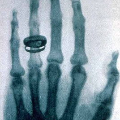Medical images often contain artificial markers added by doctors, which can negatively affect the accuracy of AI-based diagnosis. To address this issue and recover the missing visual contents, inpainting techniques are highly needed. However, existing inpainting methods require manual mask input, limiting their application scenarios. In this paper, we introduce a novel blind inpainting method that automatically completes visual contents without specifying masks for target areas in an image. Our proposed model includes a mask-free reconstruction network and an object-aware discriminator. The reconstruction network consists of two branches that predict the corrupted regions with artificial markers and simultaneously recover the missing visual contents. The object-aware discriminator relies on the powerful recognition capabilities of the dense object detector to ensure that the markers of reconstructed images cannot be detected in any local regions. As a result, the reconstructed image can be close to the clean one as much as possible. Our proposed method is evaluated on different medical image datasets, covering multiple imaging modalities such as ultrasound (US), magnetic resonance imaging (MRI), and electron microscopy (EM), demonstrating that our method is effective and robust against various unknown missing region patterns.
翻译:医学图像中常常包含由医生添加的人工标记,这可能会对基于人工智能的诊断准确性产生不利影响。为解决这个问题并恢复缺失的视觉内容,需要高度需求的修补技术。然而,现有的修补方法需要人工输入掩模,限制了它们的应用场景。在本文中,我们介绍了一种新颖的盲修补方法,它可以在不指定图像目标区域的掩模的情况下自动完成视觉内容。我们提出的模型包括一个无掩模重建网络和一个物体感知鉴别器。重建网络包括两个分支,预测带人工标记的损坏区域并同时恢复缺失的视觉内容。物体感知鉴别器依靠密集物体探测器的强大识别能力,确保重构图像中的标记不能在任何局部区域检测到。因此,重构图像尽可能与干净图像接近。我们提出的方法在不同医学图像数据集上进行评估,涵盖多种成像模式,如超声(US)、核磁共振成像(MRI)和电子显微镜(EM),证明我们的方法对于各种未知缺失区域模式是有效和鲁棒的。

